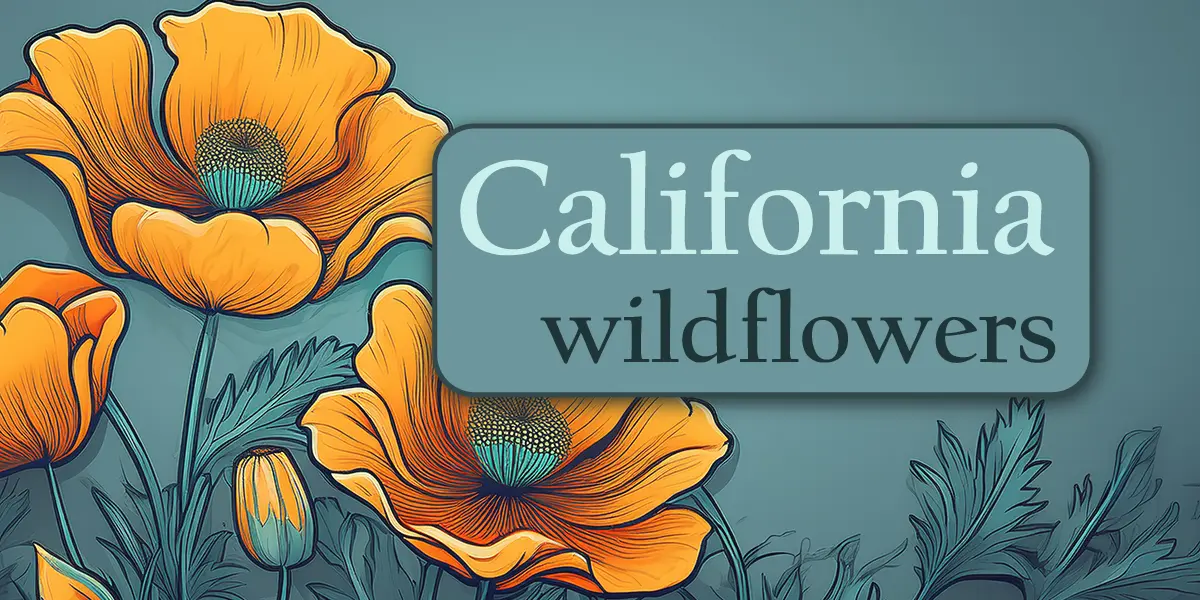Do you love flowers but hate weeding, watering, and replanting every spring?
Native California flowers may be the answer. These drought-tolerant, resilient blooms are perfectly adapted to Southern California’s climate, meaning less water, less effort, and a big payoff of vibrant colors and flourishing greenery.
We’ve listed our favorite wildflowers for an eco-friendly, low-sweat garden. We’ve outlined bloom periods and special care requirements to help you make the best choices for planting. And if you can’t decide, you can plant them all (and see which survive)!
USDA Hardiness Zones in Southern California
The USDA Plant Hardiness Zone Map divides the United States into zones based on average annual minimum winter temperatures. Southern California’s hardiness zones range from 8b to 11, depending on elevation, proximity to the coast, and desert influences.
Coastal areas fall into warmer zones, such as 10 and 11, which rarely experience frost and are suitable for tropical perennials. Inland areas might range between Zones 8b and 10, where mild winters and occasional frost must be considered.
For best results, always cross-reference the hardiness zone of potential plants with your location.
1. California Poppy (Eschscholzia californica)
The California state flower is vibrant, drought-tolerant, and prized for its silky orange petals and fern-like blue-green foliage.
- Bloom Period: Spring to late summer.
- Bloom Duration: Not specified in the provided search results.
- Light Requirements: Full sun, at least 6–8 hours of direct sunlight daily. Flowers close in the absence of sunlight.
- Soil Type: Sandy, well-drained soil.
- Height: Reaches 1–2 ft.
- Hardiness Zones: 6–10. It can be perennial in milder areas.
- Native Habitat: Hot, dry climates in the western United States.
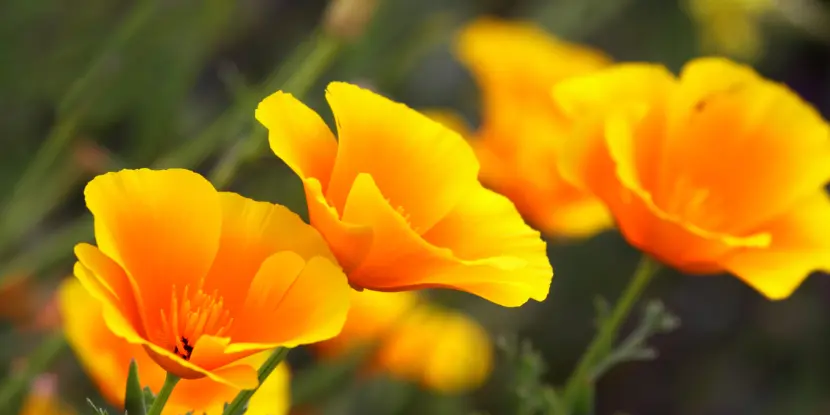
The California Poppy is vibrant, drought-tolerant, and admired for its silky orange petals and fern-like blue-green foliage.
Propagation
- Sow seeds directly outdoors after the last frost or in the fall for earlier blooms the following season.
- Lightly press seeds into the soil without covering, as light aids germination.
- Readily self-sows under favorable conditions, often returning annually without replanting.
Special Characteristics
- State flower of California.
- Feathery, blue-green foliage.
- Flowers close in the absence of sunlight.
Other Considerations
- Cooler temperatures and adequate rainfall can prolong the blooming season. Extreme heat or drought conditions may shorten it.
- Regularly removing spent flowers can encourage the plant to produce more blooms.
2. Sticky Monkeyflower (Diplacus aurantiacus)
Sticky monkeyflower is a hardy evergreen shrub with tubular orange to red flowers that attract hummingbirds and butterflies. Its sticky, resinous leaves help conserve moisture.
- Bloom Period: Late spring to early fall.
- Bloom Duration: Several days.
- Light Requirements: Full sun at least six hours daily.
- Soil Type: Tolerates various well-draining soil types.
- Height: Grows up to 4 ft as a small shrub.
- Hardiness Zones: 7–10.
- Native Habitat: California and just beyond its borders.
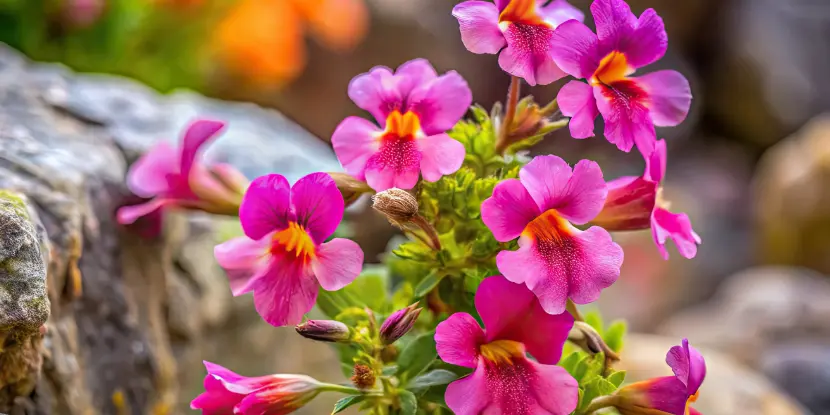
Sticky monkeyflower is a hardy evergreen shrub with tubular orange to red flowers that attract hummingbirds and butterflies.
Propagation
- Seeds: Sow in fall or early spring in well-draining soil; germination occurs in 3-4 weeks.
- Cuttings: Take softwood cuttings in late spring or early summer; root development takes 4-6 weeks.
- Division: Divide mature plants in late fall or early spring to propagate
Special Characteristics
- Also called Mimulus aurantiacus.
- Evergreen shrub.
- Beloved by hummingbirds.
Other Considerations
- In most cases, Red Bush Monkeyflower must go semi-deciduous in the summer.
- Direct watering in late summer or fall can cause root rot for Red Bush Monkeyflower.
3. California Fuchsia (Epilobium canum)
This low-growing perennial bursts into vivid red, trumpet-shaped blooms in late summer, providing a vital nectar source for hummingbirds.
- Bloom Period: Typically from Summer through October.
- Bloom Duration: Several days.
- Light Requirements: At least 6 hours of direct sunlight daily for profuse flowering. Tolerates partial shade.
- Soil Type: Well-drained soils. Can use fast or slow-draining soil.
- Height: Grows up to 1–2 ft.
- Hardiness Zones: 8–10, sometimes less.
- Native Habitat: Many dry areas throughout California.
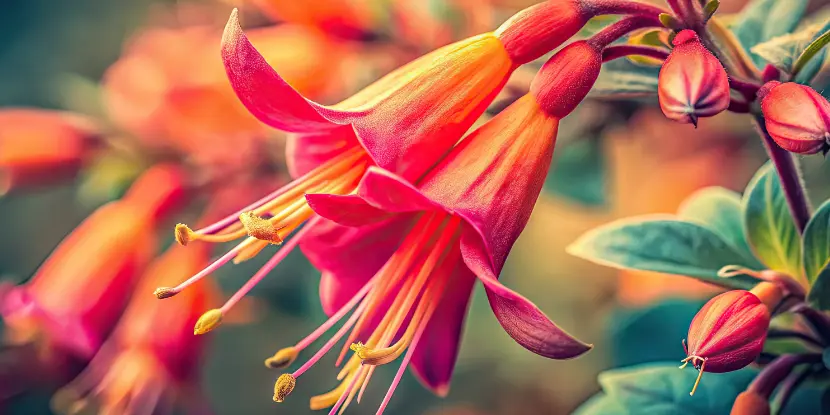
California Fuchsia bursts into vivid red, trumpet-shaped blooms in late summer.
Propagation
- Seeds: Collect mature seeds in early fall; they require cold stratification before sowing.
- Cuttings: Take softwood cuttings in spring or early summer.
- Division: Divide rhizomes in early spring or late fall.
Special Characteristics
- A low-growing perennial plant with striking summer flowers.
- Virtually pest and disease free.
Other Considerations
- Usually needs no pruning.
4. Yarrow (Achillea millefolium)
This perennial features clusters of small white flowers and feathery, aromatic leaves, and is valued for its medicinal properties and ability to attract pollinators.
- Bloom Period: Late April to early July (South), mid-July to mid-September (North).
- Bloom Duration: 6–8 weeks.
- Light Requirements: Full sun to part shade. Full sun helps it stay compact and yields many blooms.
- Soil Type: Does well in lean, dry to medium, well-drained sandy loams. Tolerates poor soils with good drainage.
- Height: 1–3 ft.
- Hardiness Zones: 3–9.
- Native Habitat: Native to most of the US, including California.
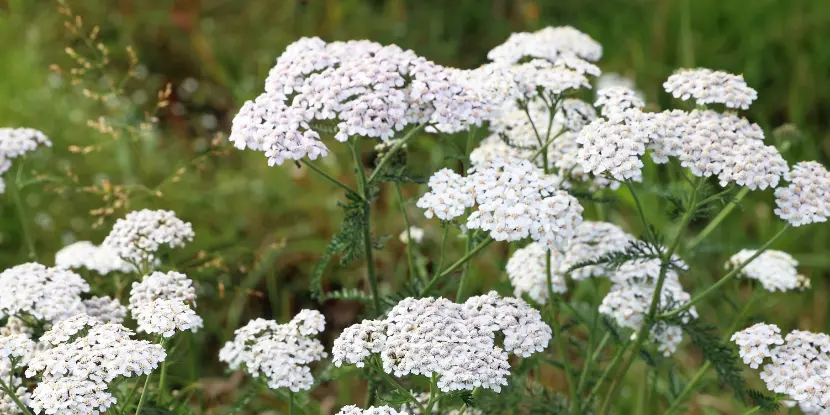
Yarrow is valued for its medicinal properties and ability to attract pollinators.
Propagation
- Sow seeds in spring; germination occurs in 14–21 days.
- Divide clumps every 2–3 years in spring or fall to maintain vigor.
Special Characteristics
- Usually needs no pruning.
Other Considerations
- Can spread aggressively via rhizomes; consider containment strategies.
- Attracts bees, butterflies, and other pollinators.
- Deer-resistant and drought-tolerant once established.
- Fragrant foliage with a fern-like appearance.
- Traditionally used for its anti-inflammatory and wound-healing properties.
5. Showy Milkweed (Asclepias speciosa)
Showy Milkweed bears striking, fragrant, pinkish-purple flowers and is vital in supporting pollinators, especially monarch butterflies.
- Bloom Period: May through September.
- Bloom Duration: Several days.
- Light Requirements: 6–8 hours of direct sunlight daily.
- Soil Type: Average, dry to medium, well-drained soils. Does well in poor, dry, gravelly soils.
- Height: 2–4 ft.
- Hardiness Zones: 3–9.
- Native Habitat: Western and central North America.
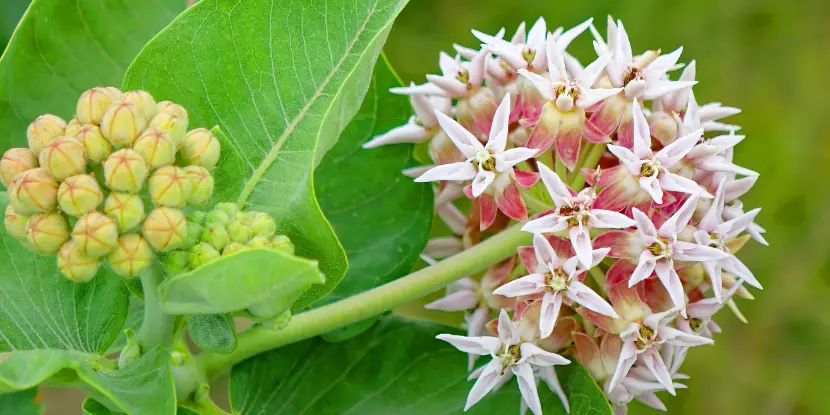
Showy Milkweed is vital in supporting pollinators, especially monarch butterflies.
Propagation
Seeds
- Collect seeds from mature pods in late summer to early fall.
- Perform cold stratification by refrigerating seeds for 30 days before sowing.
- Sow seeds directly outdoors in late fall or early spring.
Rhizome Cuttings
- In late fall to early spring, divide the plant’s rhizomes, ensuring each section has at least one bud.
- Plant rhizome sections 4 to 6 inches deep in well-drained soil.
Special Characteristics
- Attracts a variety of pollinators, including monarch butterflies, bees, and hummingbirds.
- Serves as a host plant for monarch butterfly caterpillars.
- Fragrant flowers add sensory appeal to gardens.
- Deer-resistant and drought-tolerant once established.
- Produces silky seed pods that can be used in dried arrangements.
Other Considerations
- The plant’s milky sap can irritate the skin and is toxic if ingested; handle with care.
- Spreads via rhizomes. While less aggressive than some milkweed species, it can form colonies over time.
- Its deep taproot makes mature plants difficult to transplant. Establish plants in their permanent location.
- Cutting back stems in late fall or early spring can promote vigorous growth.
6. Blue-Eyed Grass (Sisyrinchium bellum)
Despite its name, blue-eyed grass belongs to the iris family and is distinguished by its delicate, star-shaped blue to violet blooms with yellow centers.
- Bloom Period: January to June, with peak blooming in March to May.
- Bloom Duration: 1 day.
- Light Requirements: Full sun or part shade.
- Soil Type: Well-drained, average soil. Prefers moist to wet conditions, especially in spring.
- Height: 6–18 in.
- Hardiness Zones: 5–8, tolerating temperatures down to 20°F.
- Native Habitat: Open, grassy places below 3000 ft in California.
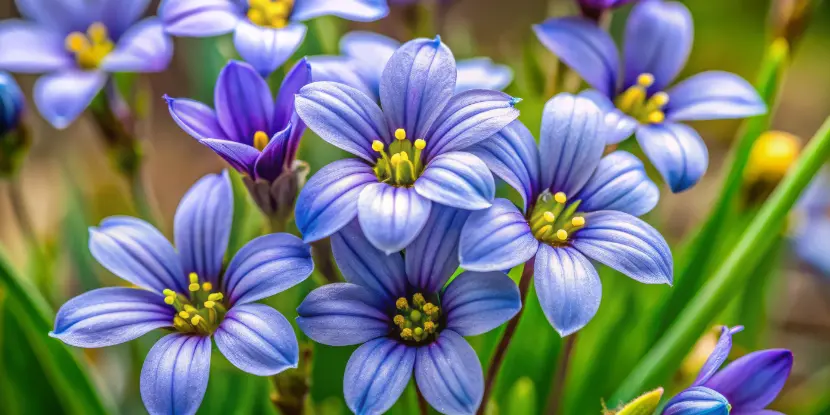
Blue-eyed grass belongs to the iris family and is distinguished by its star-shaped blue to violet blooms with yellow centers.
Propagation
- Sow seeds in fall for natural stratification; plants from seed may bloom in the second year.
- Divide clumps in early spring as new growth appears.
- Readily self-sows under favorable conditions.
Special Characteristics
- Attracts pollinators, including bees and butterflies.
- Deer-resistant and drought-tolerant once established.
- Summer dormant, dying back after flowering and re-emerging with winter rains.
- Traditionally used by indigenous American tribes for digestive ailments.
Other Considerations
- Thrives in average soil and requires little to no supplemental fertilizer.
- Requires regular moisture during growth and bloom periods; reduce watering during dormancy.
- Ideal for meadows, borders, rock gardens, and containers.
7. Western Columbine (Aquilegia formosa)
Western Columbine produces nodding flowers that are typically red with yellow accents. These distinctive blooms feature five sepals, five petals, and numerous stamens.
- Bloom Period: May through July.
- Bloom Duration: Several days.
- Light Requirements: Full sun to part shade. Grows best in dappled shade.
- Soil Type: Average, medium moisture, well-drained soils. Hates poorly drained soils.
- Height: 1–3 ft.
- Hardiness Zones: 3–9.
- Native Habitat: Western North America, from Alaska to Baja California.
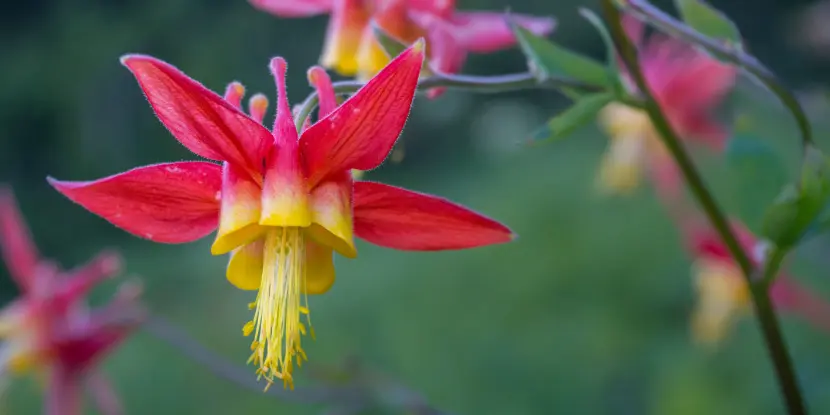
Western Columbine produces nodding flowers that are typically red with yellow accents.
Propagation
- Seeds: Sow in fall or stratify before spring planting; germination may take several weeks.
- Self-seeding: Readily self-sows under favorable conditions, often returning annually without replanting.
Special Characteristics
- Highly attractive to hummingbirds, bees, and butterflies.
- Generally resistant to deer.
- The flowers are edible, but other parts of the plant contain compounds that can be toxic if ingested in large quantities.
Other Considerations
- Deadhead spent flowers to encourage prolonged blooming.
- Requires consistent moisture, especially during dry periods.
- May be susceptible to leaf miners; monitor foliage for signs of damage.
8. Cleveland Sage (Salvia clevelandii)
Cleveland Sage is a fragrant, evergreen shrub with aromatic foliage and vibrant purple-blue flowers.
- Bloom Period: Mid-spring to late summer, with peak blooming in May and June.
- Bloom Duration: Several days.
- Light Requirements: Full sun to part shade. Requires at least 6–8 hours of direct sunlight daily.
- Soil Type: Well-drained sands and gravels, well-drained soils.
- Height: 3–5 ft.
- Hardiness Zones: 8–11, tolerating temperatures down to 20°F.
- Native Habitat: Southern California and northern Baja California, Mexico.
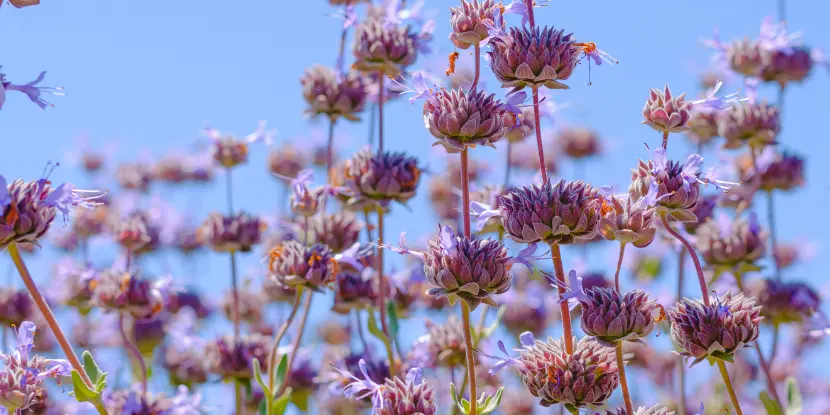
Cleveland Sage is a fragrant, evergreen shrub with aromatic foliage and vibrant purple-blue flowers.
Propagation
- Seeds: Sow in fall or early spring in well-draining soil; germination occurs in 2–4 weeks.
- Cuttings: Take semi-hardwood cuttings in late spring or early summer; roots develop in 4–6 weeks.
Special Characteristics
- Highly attractive to hummingbirds, bees, and butterflies.
- Once established, it requires minimal watering.
- Generally unpalatable to deer.
- Foliage and flowers emit a pleasant, musky aroma.
Other Considerations
- Prune after flowering to maintain shape and encourage bushier growth.
- Occasional watering during prolonged dry periods can extend blooming.
- May become woody and benefit from rejuvenation pruning every few years.
9. Purple Chinese Houses (Collinsia heterophylla)
Purple Chinese Houses bears pagoda-like tiers of purple and white blossoms. These delicate flowers attract a variety of pollinators.
- Bloom Period: March through June, with peak flowering in mid to late spring.
- Bloom Duration: 8–9 weeks.
- Light Requirements: Prefers partial shade, especially in hotter climates.
- Soil Type: Rich, moist, well-drained soils, including loamy and sandy.
- Height: 12–24 in.
- Hardiness Zones: 4–10.
- Native Habitat: Native to California in shady places, meadows, disturbed areas, and oak woodlands.
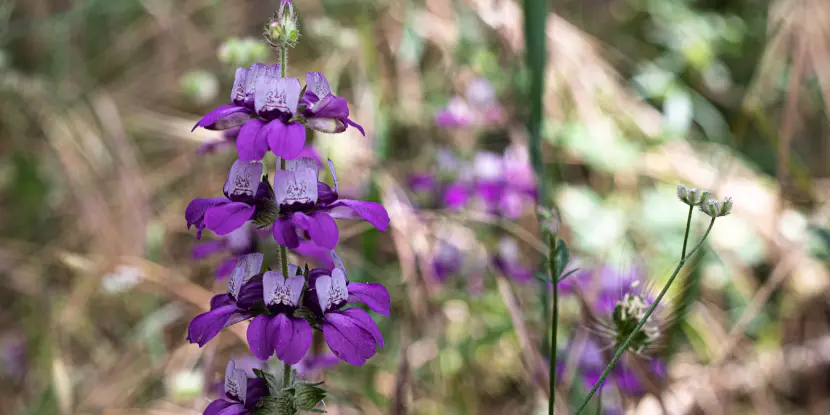
Purple Chinese Houses is so-called because of its pagoda-like flower structure.
Propagation
- Seeds: Sow seeds on the soil surface in fall or early spring; they require light for germination and should not be covered.
- Self-seeding: Readily self-sows under favorable conditions, often returning annually without replanting.
Special Characteristics
- Highly attractive to bees, butterflies, and birds.
- Flowers are arranged in tiered whorls, resembling a pagoda, with bi-colored petals, typically purple and white.
- Generally resistant to deer browsing.
Other Considerations
- Requires regular watering during dry periods, especially when grown in full sun.
- Deadheading spent flowers can encourage prolonged blooming.
10. California Coneflower (Rudbeckia californica)
California Coneflower is a tall, bold perennial adorned with bright yellow daisy-like flowers surrounding a prominent greenish-yellow central cone.
- Bloom Period: June through November.
- Bloom Duration: 2–3 months.
- Light Requirements: Full sun (6+ hours of direct light); tolerates partial shade in hotter climates.
- Soil Type: Moist, well-drained soils; tolerates clay with consistent moisture.
- Height: 3–6 ft.
- Hardiness Zones: 5–9.
- Native Habitat: The Sierra Nevada mountains, usually at elevations of 800–2600 meters.
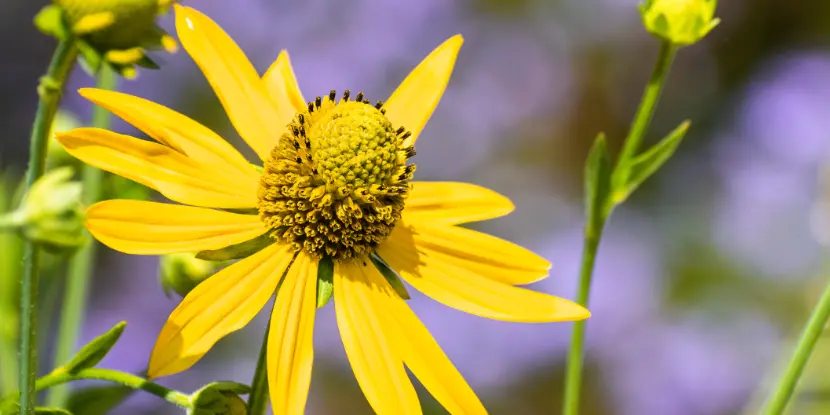
California Coneflower is a tall, bold perennial adorned with bright yellow daisy-like flowers.
Propagation
- Propagated via division of rhizomes in fall or early spring.
- Can also be grown from seeds sown in fall or after stratification.
Special Characteristics
- Excellent pollinator plant, attracting bees, butterflies, and beneficial insects.
- Rhizomatous perennial forming dense colonies over time.
- Resistant to most pests and tolerant of occasional flooding.
Other Considerations
- Requires regular moisture; will struggle in drought or poorly drained soils.
- Best suited for naturalistic gardens, rain gardens, and habitat restoration.
- Foliage may become scraggly after bloom; cutting back encourages tidy growth.
11. Lilac Verbena (Verbena lilacina)
Lilac Verbena produces airy clusters of small, lavender-purple flowers atop slender stems, creating a soft, mounding form that blooms prolifically from spring through fall.
- Bloom Period: March through October.
- Bloom Duration: Up to 8 months.
- Light Requirements: At least 6-8 hours of direct sunlight daily.
- Soil Type: Well-draining soils; tolerates loamy, sandy, and even clay soils if drainage is sufficient.
- Height: 2–3 ft.
- Hardiness Zones: 9–11.
- Native Habitat: Cedros Island off Baja California.
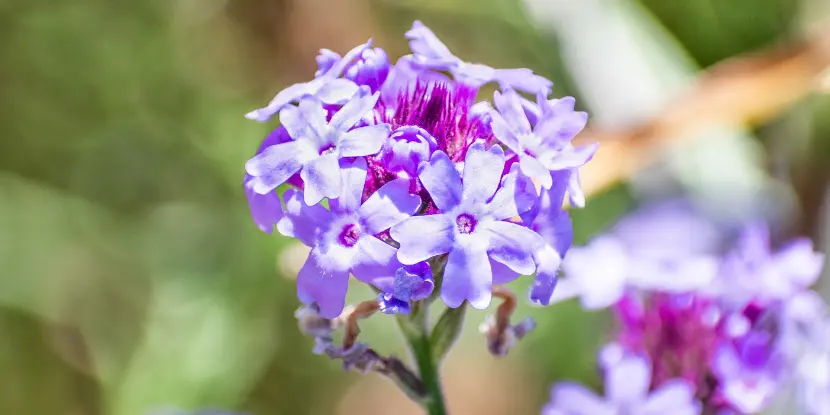
Lilac Verbena produces airy clusters of small, lavender-purple flowers atop slender stems.
Propagation
- Easily propagated by seed or softwood cuttings.
- Seeds may require light scarification for better germination rates.
- Cuttings should be taken in spring or summer for rooting in well-drained mediums.
Special Characteristics
- Drought-tolerant once established.
- Highly attractive to butterflies, bees, and other pollinators.
- Deer-resistant due to mildly aromatic foliage.
- Continuous blooming provides long-season garden interest.
Other Considerations
- May require occasional deadheading to maintain a tidy appearance.
- Sensitive to overwatering; excellent for xeriscape or water-wise gardens.
- Minimal pest or disease issues when grown in proper conditions.
12. Arroyo Lupine (Lupinus succulentus)
Arroyo Lupine produces tall, fragrant, blue to purple flower spikes from late winter through spring, creating a stunning display in gardens and wild landscapes.
- Bloom Period: February through May.
- Bloom Duration: 4 to 6 weeks.
- Light Requirements: Thrives in full sun but can tolerate partial shade.
- Soil Type: Adaptable to various well-draining soils, including clay, loam, and sandy soils.
- Height: 2–4 ft.
- Hardiness Zones: 7–10.
- Native Habitat: California, extending into adjacent areas of Arizona and Baja California.
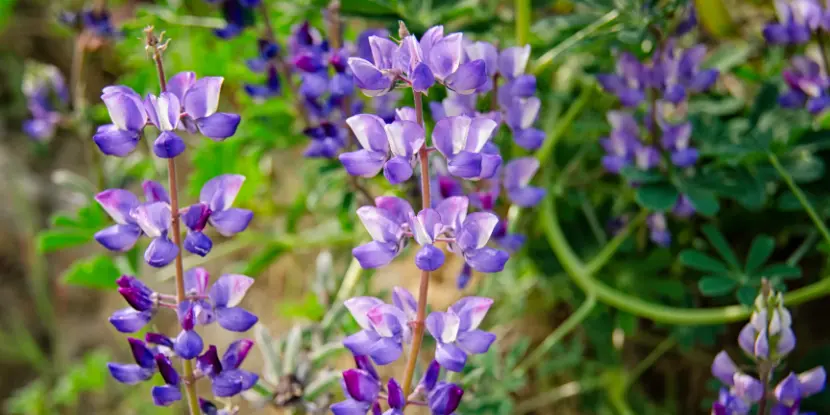
Arroyo Lupine produces tall, fragrant, blue to purple flower spikes from late winter through spring.
Propagation
- Easily propagated from seed.
- For better germination, scarify seeds or soak them in warm water before planting.
- Sow seeds 1/8 inch deep in fall or early spring.
Special Characteristics
- Attracts bees, butterflies, and hummingbirds.
- Improves soil fertility by fixing atmospheric nitrogen.
- Flowers emit a sweet fragrance.
- Deer resistant.
Other Considerations
- All plant parts are toxic if ingested; keep away from pets.
- Readily self-seeds, making it suitable for naturalized settings.
FAQs: Growing California Wildflowers
Q: How do I know which native perennial flowers will work in my yard?
Evaluate your soil type, sun exposure, and local climate. Most native California perennials thrive in full sun and well-draining soil.
Q: Can native perennials grow in containers?
Many native perennials, like California poppies and yarrow, do well in containers as long as they have proper drainage.
Q: How much water do these plants need?
Once established, most native California perennials need occasional deep watering, especially during peak summer heat.
Q: Why should I plant native flowers instead of non-native options?
Native flowers are adapted to the local climate, requiring less water, fertilizer, and upkeep. They also support native wildlife.
Q: Do native plants attract pests?
Native flowers sometimes attract insects, but these are often beneficial in pollination or as natural pest control.
Q: When is the best time to plant native perennials?
Fall is the ideal planting time, allowing roots to establish during cooler months before the spring growing season.
Q: How do I fertilize native perennials?
Most native perennials don’t need fertilizers. Healthy, well-prepared soil is usually sufficient.
Q: How do I prevent weeds in a native perennial garden?
Use mulch around your plants to suppress weeds and retain moisture.

